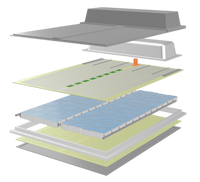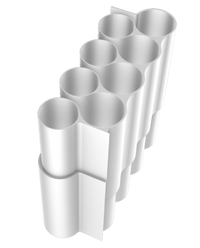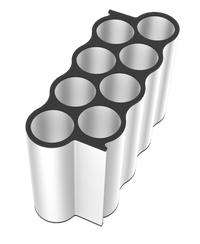A new approach to battery pack design
Conventional battery packs serve no structural function, thus making electric vehicles much heavier than they need to be. This is why the industry is moving towards structural battery packs. The most efficient way to build a structural battery pack is in the form of a sandwich structure, which consists of two face sheets and a core. We developed a new type of core structure, that offers many advantages, while being simple to manufacture and integrate.
The core structure is created by inserting two (or more) specially shaped extruded parts into one another. A small gap between the structures later functions as a cooling channel, which is sealed using two sealing caps.
The battery cells are inserted into the structure. The face sheets close the cavity, thus fixing the cells in place.
The entire lateral surface of the cells is in contact with the cooling structure, which enables a cooling performance similar to immersion cooling solutions, while maintaining the simplicity of serpentine tubes or cold plates. No module casings or additional cross-members are needed, therefore the packaging density of existing pack architectures can be matched or even exceeded.
The increased cooling performance enables higher charging rates (> 3C), leading to a fast charging time of 10 minutes or even lower. The increased packaging density leads to range increases, even when not taking the possible weight savings into account. By relying on established manufacturing processes and by reducing part count, we can reduce the pack manufacturing cost by up to 5%. Furthermore, our cooling structures can inhibit thermal propagation, if a cell catches fire, which increases safety. As described prior, the cells are only clamped into our structure and not bonded. This greatly simplifies recyclability at the end of life.
The technology is completely tailorable and can be applied to all cell dimensions and form factors. It has been applied for patent.





